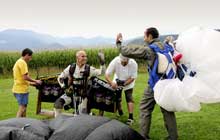Jet man ready for cross-Channel attempt after 'awesome' test flight
From here.
Pilot Yves Rossy landed safely yesterday after reaching speeds of 180mph strapped to a jet-powered wing
- guardian.co.uk,
- Thursday August 21 2008 17:58 BST
- Article history

Yves Rossy soars over Switzerland yesterday strapped to a jet-powered wing. The flight was a test run for a cross-Channel attempt next month
A Swiss daredevil's bid to cross the English Channel propelled by a jet-powered wing strapped to his back moved a step closer yesterday with a successful 36km test flight over Switzerland.
The flight proves that his jet-powered wing can take him far enough to make it across the channel from Calais to Dover. He hopes to make the crossing on 24 September if the weather is suitable.
Yves Rossy – who calls himself FusionMan – jumped from a plane above the Swiss town of Bex and reached speeds of up to 180mph during his 12 minutes of jet-powered flight before landing at an airfield in Villeneuve. Rossy first unveiled his jet-powered wing in May with an 8-minute aerobatic display over the Alps.
"Everything went well, it was awesome," said Rossy after the flight. "It's my longest flight with this wing. If there are no technical problems, it's OK for the English Channel. I can't wait for this next challenge!"
His attempt had originally been thwarted by a collection of technical failures, including a leaking gas tank and two aborted flights during which the engines stopped within seconds of jumping from his support plane. He blamed these failures – which forced him to deploy his parachutes early – on "electronic interference problems".
The successful flight involved him jumping out of the aircraft at 2,300m, flying horizontally under jet power from a height of 1,700m and then switching off the jet engines before deploying two parachutes at 1500m and 1200m.
The wing does not include moving parts such as flaps to control direction, but Rossy is able to steer by shifting his weight and moving his head.
When he reached the ground he still had 2 litres of fuel left in his wing, suggesting that he would have some margin for error during the cross-channel flight.
Rossy is a former military pilot. His channel flight will be streamed live on the National Geographic Channel.



